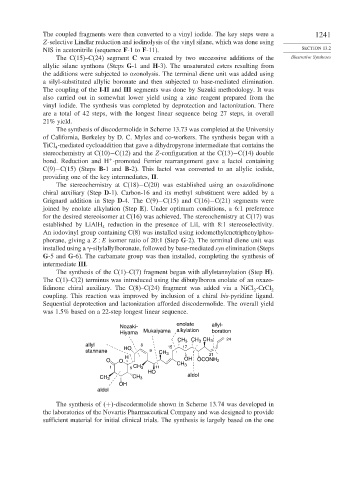Page 1265 - Advanced Organic Chemistry Part B - Reactions & Synthesis
P. 1265
The coupled fragments were then converted to a vinyl iodide. The key steps were a 1241
Z-selective Lindlar reduction and iodinolysis of the vinyl silane, which was done using
NIS in acetonitrile (sequence F-1 to F-11). SECTION 13.2
The C(15)–C(24) segment C was created by two successive additions of the Illustrative Syntheses
allylic silane synthons (Steps G-1 and H-3). The unsaturated esters resulting from
the additions were subjected to ozonolysis. The terminal diene unit was added using
a silyl-substituted allylic boronate and then subjected to base-mediated elimination.
The coupling of the I-II and III segments was done by Suzuki methodology. It was
also carried out in somewhat lower yield using a zinc reagent prepared from the
vinyl iodide. The synthesis was completed by deprotection and lactonization. There
are a total of 42 steps, with the longest linear sequence being 27 steps, in overall
21% yield.
The synthesis of discodermolide in Scheme 13.73 was completed at the University
of California, Berkeley by D. C. Myles and co-workers. The synthesis began with a
TiCl -mediated cycloaddition that gave a dihydropyrone intermediate that contains the
4
stereochemistry at C(10)−C(12) and the Z-configuration at the C(13)−C(14) double
+
bond. Reduction and H -promoted Ferrier rearrangement gave a lactol containing
C(9)−C(15) (Steps B-1 and B-2). This lactol was converted to an allylic iodide,
providing one of the key intermediates, II.
The stereochemistry at C(18)−C(20) was established using an oxazolidinone
chiral auxiliary (Step D-1). Carbon-16 and its methyl substituent were added by a
Grignard addition in Step D-4. The C(9)−C(15) and C(16)−C(21) segments were
joined by enolate alkylation (Step E). Under optimum conditions, a 6:1 preference
for the desired stereoisomer at C(16) was achieved. The stereochemistry at C(17) was
established by LiAlH reduction in the presence of LiI, with 8:1 stereoselectivity.
4
An iodovinyl group containing C(8) was installed using iodomethylenetriphenylphos-
phorane, giving a Z
E isomer ratio of 20:1 (Step G-2). The terminal diene unit was
installed using a -silylallylboronate, followed by base-mediated syn elimination (Steps
G-5 and G-6). The carbamate group was then installed, completing the synthesis of
intermediate III.
The synthesis of the C(1)–C(7) fragment began with allylstannylation (Step H).
The C(1)–C(2) terminus was introduced using the dibutylboron enolate of an oxazo-
lidinone chiral auxiliary. The C(8)–C(24) fragment was added via a NiCl -CrCl 2
2
coupling. This reaction was improved by inclusion of a chiral bis-pyridine ligand.
Sequential deprotection and lactonization afforded discodermolide. The overall yield
was 1.5% based on a 22-step longest linear sequence.
Nozaki- enolate allyl-
Hiyama Mukaiyama alkylation boration
24
CH 3 CH 3 CH 3
allyl 8 15 17
stannane HO 9
CH 3 21
H
O O OH OCONH 2
CH 3
1 5 CH 3 11
HO
aldol
CH 3 CH 3
OH
aldol
The synthesis of + -discodermolide shown in Scheme 13.74 was developed in
the laboratories of the Novartis Pharmaceutical Company and was designed to provide
sufficient material for initial clinical trials. The synthesis is largely based on the one

